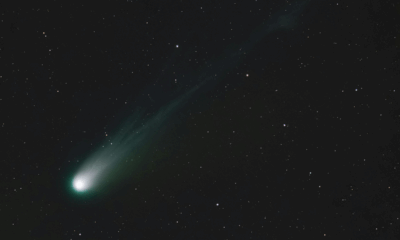Science
NASA Unveils Stunning Images of Interstellar Comet 3I/ATLAS

NASA has released new, high-resolution images of the interstellar comet 3I/ATLAS, providing a rare glimpse into an object that originated far beyond our solar system. These images, captured using a variety of NASA spacecraft and space telescopes, reveal the comet’s intricate structure and composition as it travels through the inner solar system.
The latest visuals focus on 3I/ATLAS’s coma, a dusty halo surrounding its icy nucleus, along with the trails of gas and dust streaming from it. The data was gathered through observations from several spacecraft, including those orbiting Mars, the Hubble Space Telescope, and the James Webb Space Telescope (JWST). One notable event occurred in October 2025, when 3I/ATLAS made a close approach to Mars, coming within approximately 19 million miles (30 million kilometers). This proximity enabled orbiting spacecraft to collect valuable information about the comet.
NASA’s Lucy spacecraft, which is on a mission to study Jupiter’s Trojan asteroids, also managed to capture images of 3I/ATLAS’s coma and tail during this time. Earlier images from Hubble, taken while the comet was still far from Mars, depicted a teardrop-shaped cocoon of dust enveloping the nucleus. This unique shape, particularly the asymmetry of the coma, indicates that the comet is actively shedding material as it heats up in the inner solar system.
Recent spectroscopic studies, including observations from the JWST, have detected significant amounts of carbon dioxide, water, carbon monoxide, and cyanide in the comet. These findings are crucial for scientists aiming to understand the composition of this interstellar visitor.
Understanding 3I/ATLAS’s Journey
What makes 3I/ATLAS particularly fascinating is that it is not bound to the Sun’s gravity. Instead, it follows a hyperbolic trajectory, suggesting that it is merely passing through our solar system. Researchers view this comet as a rare messenger from another star system, offering insights into how comets may form in different regions of the galaxy.
As the comet approaches Earth, many are curious about its trajectory. According to NASA, 3I/ATLAS will make its closest approach to Earth in mid-December 2025, at a distance of about 167 million miles (269 million kilometers). This distance, equivalent to approximately 1.8 astronomical units (AU), is nearly twice the average distance between the Earth and the Sun. Importantly, this means that 3I/ATLAS poses no threat to our planet.
Multiple reports confirm that there is no risk of the comet impacting Earth. Instead, this close pass presents a unique scientific opportunity for researchers and astronomers. NASA and various space agencies are continuing to monitor 3I/ATLAS closely, utilizing both ground-based and space telescopes to track its behaviour and composition as it travels through our solar system.
After its December flyby, 3I/ATLAS is expected to head back into interstellar space, marking the end of its brief visit to our celestial neighborhood. As scientists analyze the data collected during this encounter, they hope to uncover more about the origins and nature of this remarkable interstellar traveler.
-

 Entertainment3 months ago
Entertainment3 months agoAnn Ming Reflects on ITV’s ‘I Fought the Law’ Drama
-

 Entertainment4 months ago
Entertainment4 months agoKate Garraway Sells £2 Million Home Amid Financial Struggles
-

 Health3 months ago
Health3 months agoKatie Price Faces New Health Concerns After Cancer Symptoms Resurface
-

 Entertainment3 months ago
Entertainment3 months agoCoronation Street’s Carl Webster Faces Trouble with New Affairs
-

 Entertainment3 months ago
Entertainment3 months agoWhere is Tinder Swindler Simon Leviev? Latest Updates Revealed
-

 Entertainment4 months ago
Entertainment4 months agoMarkiplier Addresses AI Controversy During Livestream Response
-

 Science1 month ago
Science1 month agoBrian Cox Addresses Claims of Alien Probe in 3I/ATLAS Discovery
-

 Entertainment4 months ago
Entertainment4 months agoKim Cattrall Posts Cryptic Message After HBO’s Sequel Cancellation
-

 Entertainment2 months ago
Entertainment2 months agoOlivia Attwood Opens Up About Fallout with Former Best Friend
-

 Entertainment3 months ago
Entertainment3 months agoMasterChef Faces Turmoil as Tom Kerridge Withdraws from Hosting Role
-

 Entertainment4 months ago
Entertainment4 months agoSpeculation Surrounds Home and Away as Cast Departures Mount
-

 World2 months ago
World2 months agoCole Palmer’s Mysterious Message to Kobbie Mainoo Sparks Speculation





















